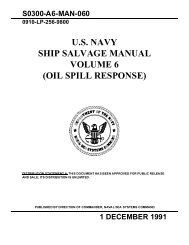April 2007 - Supervisor of Salvage and Diving
April 2007 - Supervisor of Salvage and Diving
April 2007 - Supervisor of Salvage and Diving
You also want an ePaper? Increase the reach of your titles
YUMPU automatically turns print PDFs into web optimized ePapers that Google loves.
On 21 September 2006, the U.S. Navy<br />
<strong>Diving</strong> community moved one step<br />
closer to finalizing the procedure to use<br />
the Underwater Friction Stud Welding<br />
System for Underwater Ship<br />
Husb<strong>and</strong>ry (UWSH) applications<br />
around the fleet. The underwater<br />
friction stud welding project began<br />
in 2003 with the mission to develop<br />
a reliable, cost effective, <strong>and</strong> userfriendly<br />
method <strong>of</strong> attaching<br />
studs <strong>and</strong> bosses to the exterior<br />
hull <strong>of</strong> Naval vessels. Numerous<br />
underwater applications await the<br />
approval <strong>of</strong> the friction stud welding<br />
system to include sacrificial anode<br />
<strong>and</strong> temporary padeye attachment,<br />
installation <strong>of</strong> external cover plates,<br />
<strong>and</strong> installation <strong>of</strong> c<strong>of</strong>ferdams. Most, if<br />
not all, <strong>of</strong> these applications currently<br />
require legacy underwater welding<br />
procedures <strong>and</strong> techniques, but the current<br />
welding procedures can be replaced with<br />
friction stud welding procedures once the<br />
technology is approved for use.<br />
Navy Divers working to position the Underwater Friction Welding<br />
System to weld a stud in place.<br />
From 19-21 September 2006, ten U.S.<br />
Navy Divers tested the Underwater Friction<br />
Stud Welding System at the Naval<br />
Surface Warfare Center in Carderock, MD<br />
(NSWC CD). The Office <strong>of</strong> the <strong>Supervisor</strong><br />
<strong>of</strong> <strong>Salvage</strong> <strong>and</strong> <strong>Diving</strong> (SUPSALV)<br />
<strong>and</strong> NAVSEA 05M oversaw the testing<br />
<strong>and</strong> managed the test plan which was approved<br />
by the Navy Experimental <strong>Diving</strong><br />
Unit (NEDU). The Fusion Bonding System<br />
(FBS), manufactured by Fusematic<br />
Incorporated, was the specific friction stud<br />
welder evaluated during this testing phase.<br />
Navy Divers conducted all testing in<br />
the Explosives Test Pond Facility at<br />
Navy Divers preparing to conduct Friction Stud Welding Tests.<br />
NSWC CD, <strong>and</strong> all Navy Divers received<br />
h<strong>and</strong>s-on training to setup <strong>and</strong> operate the<br />
stud welding system for both topside <strong>and</strong><br />
underwater applications. The Explosives<br />
Test Pond Facility is a 24-foot deep test<br />
basin containing 3.5 million gallons <strong>of</strong><br />
water. The visibility in the controlled<br />
environment was a crystal<br />
clear 100 feet, <strong>and</strong> the<br />
water temperature was a<br />
balmy 80 F. All Divers<br />
donned the EXO 26<br />
<strong>Diving</strong> Mask with umbilical<br />
communications <strong>and</strong><br />
a single 80 cu. ft. SCUBA<br />
cylinder to conduct<br />
the tests.<br />
The Navy Divers<br />
worked for three<br />
days to complete<br />
the extensive test<br />
plan to ensure all test plates were<br />
completed with the utmost quality.<br />
The Fusematic Fusion Bonding<br />
System used for testing<br />
weighed 40 pounds on the surface<br />
which increased the complexity <strong>of</strong><br />
the welding process at depth. Navy Divers<br />
used the Fusion Bonding System to weld<br />
30 studs <strong>and</strong> 30 bosses to small test coupons<br />
in the vertical position at 20 FFW.<br />
The small test coupons were made up <strong>of</strong><br />
three different types <strong>of</strong> base material<br />
similar to those utilized in the Fleet,<br />
DH-36, HY-80, <strong>and</strong> HY-100. Navy<br />
Divers also welded 24 studs <strong>and</strong> 24<br />
bosses to large test plates in<br />
the vertical position which<br />
were also made <strong>of</strong> DH-36,<br />
HY-80, <strong>and</strong> HY-100. NAVSEA<br />
05M <strong>and</strong> NSWC CD inspected<br />
all <strong>of</strong> the completed test<br />
articles <strong>and</strong> relocated them<br />
to a test facility at NSWC<br />
CD where they were submerged<br />
in sea water to be<br />
tested for the next three<br />
months.<br />
Although the <strong>of</strong>ficial test<br />
results remain to be fully<br />
evaluated, each Diver confirmed that<br />
the friction stud welding system <strong>and</strong> the<br />
associated procedure were user-friendly<br />
<strong>and</strong> will be a great asset to the Fleet.<br />
The next step in the approval process<br />
is to conduct an in-service test on one<br />
<strong>of</strong> our U.S. Naval vessels. SUPSALV<br />
is looking for any <strong>and</strong> all c<strong>and</strong>idates<br />
to exercise these tests, so keep an eye<br />
out on the waterfront for possible field<br />
applications. Do you want to be the<br />
first Dive Locker to use the Underwater<br />
Friction Stud Welding System for Fleet<br />
application?<br />
Navy Divers aligning the Friction Stud Welder.<br />
LT Jay Young is an Engineering Duty<br />
Officer/Diver currently working as a Project<br />
Manager at the Underwater Ship Husb<strong>and</strong>ry<br />
Division at NAVSEA 00C.<br />
A p r i l 2 0 0 7 3

















